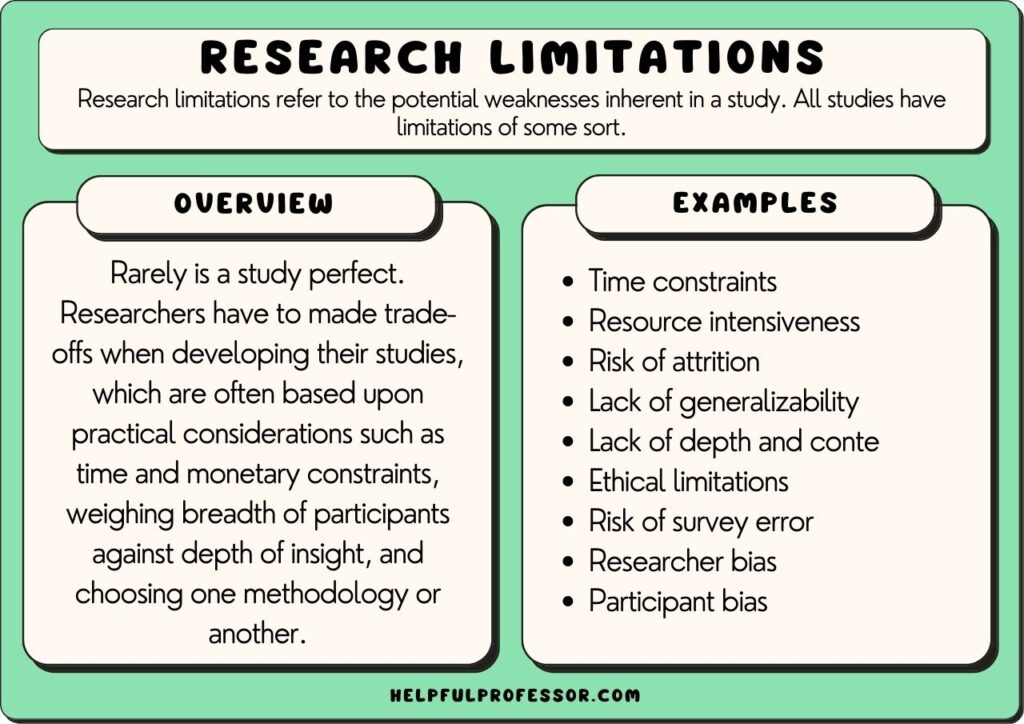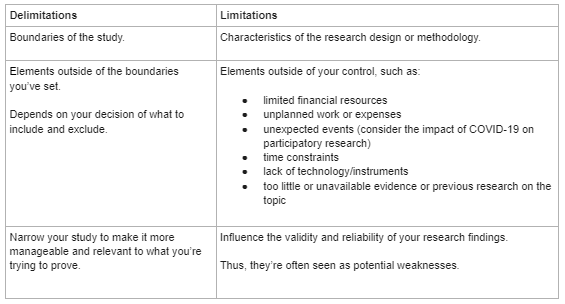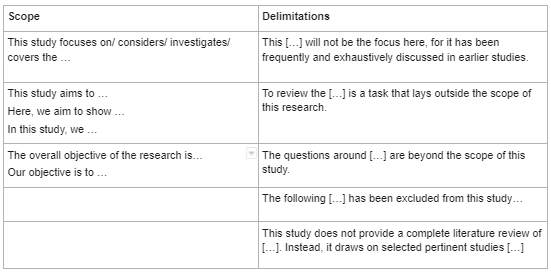What Is Scope And Limitation In Research?

- Post author By admin
- April 16, 2024
Research is the cornerstone of progress in any field, be it science, social sciences, or humanities. But behind every research endeavor lies a crucial aspect that often goes unnoticed by many: the scope and limitation. In this blog, we’ll delve into what is scope and limitation in research, why they matter, and how they influence the outcome of a study.
Table of Contents

What Are The Main 10 Stages Of Research Process?
The research process typically involves several stages, each crucial for the successful completion of a study. Here are the main 10 stages of the research process:
- Identifying the Research Problem: This stage involves identifying a topic or issue that warrants investigation. Researchers should ensure the problem is significant, relevant, and feasible for study.
- Reviewing the Literature: Conducting a thorough review of existing literature on the chosen topic is essential. This helps researchers figure out what we already know, spot where there are holes in our knowledge, and make their research questions clearer.
- Formulating Research Questions or Hypotheses: Based on the identified research problem and literature review, researchers develop specific research questions or hypotheses that they aim to address through their study.
- Designing the Research Methodology: This stage involves selecting the appropriate research design, methods, and techniques for data collection and analysis. Researchers must consider factors such as the research objectives, the nature of the data, and ethical considerations.
- Sampling: Researchers need to determine the sampling strategy and select participants or samples that represent the population of interest. Sampling methods may vary depending on the research design and objectives.
- Data Collection: This stage involves collecting data using the chosen methods and techniques. Data collection may involve surveys, interviews, observations, experiments, or analysis of existing data, among other methods.
- Data Analysis: After collecting data, researchers look at it carefully using the right tools to figure out what it means. They want to find important ideas, check if their guesses are right, and answer the questions they’re studying.
- Interpreting Results: Researchers analyze the results of their data to understand how they relate to the questions or guesses they had at the beginning of their study. They assess the significance of the results, identify patterns or trends, and draw conclusions.
- Drawing Conclusions and Implications: Based on the interpretation of results, researchers draw conclusions regarding the research questions or hypotheses. They discuss the implications of their findings, their relevance to theory or practice, and any recommendations for future research or applications.
- Writing and Presenting the Research Report: Finally, researchers write a comprehensive research report detailing the entire research process, from problem identification to conclusions. The report typically includes an introduction, literature review, methodology, results, discussion, and conclusion. Researchers may also present their findings at conferences or publish them in academic journals.
Scope in Research
- Definition: The scope of research outlines the boundaries and extent of the study.
- Components: It includes various elements such as research objectives, questions, methodology, timeframe, and geographic coverage.
- Guiding Factor: Scope guides researchers in determining what aspects of the topic will be included in the study and what will be excluded.
- Clarity: Defining the scope ensures clarity and focus, preventing researchers from straying off-topic.
- Relevance: It helps in ensuring that the research addresses pertinent issues and contributes meaningfully to the existing body of knowledge.
Limitation in Research
- Definition: Limitations refer to constraints or weaknesses within the research study that may impact its validity or generalizability.
- Types: Limitations can arise due to various factors such as methodological constraints, resource limitations, scope constraints, ethical considerations, and time constraints.
- Acknowledgement: Researchers should openly acknowledge limitations to maintain transparency and credibility.
- Mitigation: While some limitations may be unavoidable, researchers can mitigate their impact through careful planning, rigorous methodology, and transparent reporting.
- Future Implications: Identifying and addressing limitations can provide valuable insights for future research, guiding researchers in overcoming similar challenges in subsequent studies.
What Is Scope And Limitation In Research Example?
Scope in research example.
Let’s consider a research study investigating the impact of social media usage on teenagers’ mental health in urban areas of a particular city over the past three years. The scope of this study would include:
- Research Goals: We want to understand how using social media affects how teenagers feel.
- Research Questions: How much do teenagers in cities use social media, and for how long? Does using social media relate to how teenagers feel, like if they feel sad or anxious?
- Research Methodology: Utilizing surveys and interviews to gather data on social media usage patterns and mental health indicators.
- Timeframe: The study will focus on data collected over the past three years to capture recent trends and changes.
- Geographic Coverage: The study will concentrate on urban areas within a specific city, ensuring relevance and context specificity.
Limitation in Research Example
In the same study, limitations may arise due to various factors:
- Methodological Limitation: The reliance on self-reported data from surveys and interviews may introduce response bias and inaccuracies.
- Resource Limitation: Limited funding and time constraints may restrict the sample size and the depth of data collection, potentially affecting the study’s comprehensiveness.
- Scope Limitation: Focusing solely on urban areas may limit the generalizability of the findings to rural or suburban populations.
- Ethical Limitation: Ensuring informed consent and protecting the privacy of participants may pose ethical challenges, especially when dealing with sensitive topics like mental health.
- Time Limitation: The study’s timeframe of three years may not capture long-term effects or trends in social media usage and mental health outcomes.
In this example, the scope defines the parameters and objectives of the study, while the limitations highlight potential constraints and challenges that may impact the research process and findings.
How Do You Write Scope And Limitations In Research?
Writing the scope and limitations section in a research paper involves clearly defining the parameters of your study and acknowledging any constraints or weaknesses that may impact its validity or generalizability. Here’s a step-by-step guide on how to write the scope and limitations in research:
- Begin with the Scope
- Start by defining the scope of your research. This involves outlining the boundaries and extent of your study.
- Clearly state the objectives of your research and the specific aspects you will investigate.
- Identify the research questions or hypotheses that you aim to address.
- Describe the methodology you will use, including data collection and analysis techniques.
- Specify the timeframe and geographic coverage of your study.
- Be Concise and Specific
- Avoid ambiguity by being concise and specific in your description of the scope. Clearly define what will be included in your study and what will be excluded.
- Use clear and precise language to convey the scope of your research to your readers.
- Acknowledge Limitations
- After defining the scope, acknowledge any limitations or constraints that may impact your study.
- Identify potential methodological limitations, such as sample size, data collection methods, or measurement tools.
- Consider resource limitations, including funding, time, and access to data or participants.
- Discuss any scope limitations, such as geographic or demographic restrictions.
- Address ethical considerations and any potential biases or confounding factors.
- Provide Justification
- Explain why these limitations are relevant to your study and how they may affect the interpretation of your results.
- Justify your choices and decisions regarding the scope and limitations of your research.
- Demonstrate awareness of potential challenges and demonstrate transparency in your reporting.
- Offer Recommendations
- Despite limitations, suggest ways to mitigate their impact or address them in future research.
- Provide recommendations for researchers who may encounter similar constraints in their own studies.
- Highlight the implications of your research findings in light of the acknowledged limitations.
- Review and Revise
- Review your scope and limitations section to ensure clarity, coherence, and accuracy.
- Revise as needed to ensure that your description accurately reflects the parameters of your study and acknowledges any potential constraints.
In conclusion (of what is scope and limitation in research), scope and limitation are integral components of any research project. Understanding the scope helps researchers define the boundaries and parameters of their study, while acknowledging limitations ensures transparency and credibility.
By carefully considering scope and limitation, researchers can conduct more rigorous and meaningful studies that contribute to the advancement of knowledge in their respective fields.
- australia (2)
- duolingo (13)
- Education (285)
- General (77)
- How To (18)
- IELTS (127)
- Latest Updates (163)
- Malta Visa (6)
- Permanent residency (1)
- Programming (31)
- Scholarship (1)
- Sponsored (4)
- Study Abroad (187)
- Technology (12)
- work permit (8)
Recent Posts

Reference.com
What's Your Question?
- History & Geography
- Science & Technology
- Business & Finance
- Pets & Animals
What Are Scope and Limitations in Research?

Scope and limitations are two terms that address the details of a research project. The term scope refers to the problem or issue that the researcher wants to study with the project. Limitations is the term used for constraints that impact the researcher’s ability to effectively study the scope of the project.
Identifying the Scope of a Project
One of the first tasks you need to do when completing research is to identify the scope of the project. When identifying the scope, you need to address not only the problem or issue that you want to study but the population that you want to examine.
For example, assume your project strives to research the impact of sleep quality on productivity. Who will you study when examining productivity? Are you interested in worker productivity, student productivity, or general productivity? What demographic do you want to examine? You might ultimately decide that you want to study student productivity for students between the ages of 18 and 19.
H ow to Identify the Project Scope
Identifying the project’s scope sounds easy in theory, but it can take days or even weeks for researchers to identify a reasonable scope for the project. Though you might want to study the problem in as large a sample as possible, this usually isn’t the best idea for an efficient project. It’s time-consuming and expensive to thoroughly examine a problem when the scope is too wide.
A better option is to use a narrower scope for each study and complete multiple studies if necessary. If your goal is to learn how sleep quality affects productivity, you don’t want to examine productivity in workers, students, and stay-at-home parents with one study. Instead, complete a study that examines one of these groups and complete more studies over time to study the other groups.
When identifying your scope, you should also keep the intended audience of your project in mind. Though your audience doesn’t always need to have a strong impact on your scope, if you’re not sure how to narrow your scope, you might select a group that will pertain to your audience. For example, in the previously mentioned productivity study, if your audience is corporations, you might examine worker productivity in a demographic that these corporations frequently employ.
E xamining the Reality of Project Limitations
Every project, even the ones that boast meticulous planning and seasoned researchers, have limitations. When you craft a paper that summarizes your research findings, it’s essential to include the limitations in your report. Though you may worry that identifying limitations will cause readers and other researchers to dismiss your findings, the opposite is typically true. Your audience is more likely to view your findings as credible if they know you’ve considered and examined aspects that impacted your ability to properly study the topic.
C ommon Research Limitations
There are numerous limitations that can impact your ability to complete quality research. Research limitations may be methodological (related to how the study is completed) or a lack of researcher resources (such as time and research funds).
Methodological limitations include the following:
- Small sample size
- Limited diversity in your sample size
- Lack of previous research to examine
- Improper techniques or measurements used for collecting data
Common researcher related limitations include:
- Limited access to your project respondents (perhaps due to geographical constraints)
- Time constraints
- Personal conflicts and biases
- Budget restraints
L earning from Project Limitations
One of the most important reasons to identify and document project limitations is that it permits future researchers to learn from these limitations and adjust their research accordingly. Imagine that your project studies the effects of low carbohydrate consumption on sleep quality; due to time constraints, you were only able to study your sample size for two weeks. The next researcher who wants to study this topic would know that time constraints were a limitation for your study. They can then take steps to design a study that addresses this constraint. Their study might examine their sample size for a month to see if that changes the findings.
MORE FROM REFERENCE.COM

- Privacy Policy

Home » Scope of the Research – Writing Guide and Examples
Scope of the Research – Writing Guide and Examples
Table of Contents
The scope of research is a critical element of any study, defining the boundaries within which the research operates. It sets the focus, outlines the parameters, and clarifies what the study will and will not address. A well-defined scope helps researchers maintain clarity, manage expectations, and ensure that the study remains feasible and relevant. This article provides a comprehensive guide to writing the scope of research, complete with examples and practical tips.

Scope of the Research
The scope of research outlines the extent and limitations of a study. It specifies the areas the research will cover, the aspects it will focus on, and the timeframe or context within which it operates. By defining the scope, researchers communicate what they intend to study and exclude, offering a clear understanding of the study’s objectives.
For example, a study on the effects of social media on youth behavior may limit its scope to high school students in urban areas, focusing on specific platforms like Instagram and TikTok.
Importance of Defining the Scope
- Clarity: Provides a clear focus for the research, avoiding unnecessary complexity or ambiguity.
- Feasibility: Ensures the research is manageable within available resources, time, and expertise.
- Relevance: Keeps the study aligned with its objectives and research questions.
- Expectation Management: Clearly communicates the study’s boundaries to stakeholders, such as supervisors, reviewers, or readers.
- Prevents Scope Creep: Helps avoid the addition of unrelated elements during the research process.
Key Elements of the Scope of Research
1. topic coverage.
Specify the topics, issues, or phenomena that the research will address.
- Example: “This study focuses on the impact of remote learning on student academic performance during the COVID-19 pandemic.”
2. Target Population
Define the group or demographic the research will study.
- Example: “The research targets high school students aged 14–18 in urban public schools.”
3. Geographic Location
Identify the geographical area where the research is conducted, if applicable.
- Example: “The study is limited to urban schools in New York City.”
4. Timeframe
Set the time period for the data collection or the events under study.
- Example: “This research examines data from January 2020 to December 2021.”
5. Variables or Factors
Define the key variables, parameters, or factors the study will analyze.
- Example: “The study examines the relationship between social media usage and self-esteem levels among teenagers.”
6. Exclusions
Clearly state what the research will not cover to avoid misunderstandings.
- Example: “The study does not include rural schools or students in private institutions.”
How to Write the Scope of Research
Step 1: define your research objectives.
Start by identifying the primary goals and objectives of your study. This ensures the scope aligns with the research questions or hypotheses.
- Example Objective: “To evaluate the effectiveness of virtual classrooms on student engagement.”
Step 2: Identify Boundaries
Determine the specific aspects your study will focus on, such as population, location, or variables, and exclude unrelated elements.
- Example Boundary: “This study focuses exclusively on middle school students in California.”
Step 3: Justify Your Choices
Explain why you have chosen the particular scope, ensuring it is logical and relevant to the research problem.
- Example Justification: “The study focuses on California middle schools due to their significant adoption of remote learning platforms during the pandemic.”
Step 4: Write a Clear Statement
Summarize the scope in a concise and straightforward manner, ensuring it is easy to understand.
- Example Statement: “This research explores the impact of remote learning on middle school students’ academic performance in California public schools during the 2020–2021 academic year. It does not include data from private schools or other states.”
Examples of Research Scope
Example 1: business research.
Study: The Impact of E-Commerce on Consumer Behavior Scope: “This research examines how e-commerce platforms have influenced consumer purchasing behavior in the United States during the COVID-19 pandemic. It focuses on three major platforms—Amazon, eBay, and Walmart—and analyzes data from January 2020 to December 2021. The study targets consumers aged 18–50 and excludes brick-and-mortar store shopping behaviors.”
Example 2: Education Research
Study: The Effect of Class Size on Student Achievement Scope: “This study investigates the relationship between class size and student achievement in public elementary schools in Texas. It analyzes standardized test scores from 2018 to 2021 and focuses on classes with 20–35 students. The research excludes private schools and other states.”
Example 3: Healthcare Research
Study: The Effectiveness of Telemedicine in Chronic Disease Management Scope: “This research evaluates the effectiveness of telemedicine services in managing chronic diseases such as diabetes and hypertension among adults in urban hospitals in India. Data collected from January 2020 to June 2022 are analyzed. Rural areas and pediatric patients are excluded from this study.”
Tips for Defining the Scope of Research
- Be Specific: Avoid vague descriptions; clearly define all parameters.
- Align with Objectives: Ensure the scope directly supports your research goals.
- Use Simple Language: Write in a clear and straightforward manner to avoid confusion.
- Consult Guidelines: Check any institutional or project-specific requirements for defining the scope.
- Avoid Overloading: Do not attempt to cover too many topics or variables, which could make the study unmanageable.
Common Pitfalls to Avoid
- Unclear Boundaries: Ambiguous definitions can lead to confusion about what the research includes or excludes.
- Overly Broad Scope: A wide-ranging scope can make the research unfocused and challenging to complete.
- Lack of Justification: Failing to explain why certain aspects are included or excluded can weaken the study’s rationale.
- Ignoring Feasibility: Defining a scope beyond available resources, time, or expertise can lead to project delays or failure.
The scope of research is a vital component of any study, providing clear boundaries and focus for the investigation. By defining the topic coverage, target population, geographic location, timeframe, variables, and exclusions, researchers can create a manageable and effective framework for their work. A well-defined scope ensures clarity, feasibility, and alignment with research objectives, making it easier to conduct and present findings. Whether in business, healthcare, or education, understanding and writing the scope of research is essential for producing high-quality, impactful studies.
- Creswell, J. W. (2018). Research Design: Qualitative, Quantitative, and Mixed Methods Approaches . Sage Publications.
- Babbie, E. (2020). The Practice of Social Research . Cengage Learning.
- Bryman, A. (2016). Social Research Methods . Oxford University Press.
- Booth, W. C., Colomb, G. G., & Williams, J. M. (2016). The Craft of Research . University of Chicago Press.
- Flick, U. (2018). An Introduction to Qualitative Research . Sage Publications.
About the author
Muhammad Hassan
Researcher, Academic Writer, Web developer
You may also like

Thesis Format – Templates and Samples

Theoretical Framework – Types, Examples and...

Delimitations in Research – Types, Examples and...

Implications in Research – Types, Examples and...

Research Approach – Types Methods and Examples

Dissertation Methodology – Structure, Example...
21 Research Limitations Examples

Chris Drew (PhD)
Dr. Chris Drew is the founder of the Helpful Professor. He holds a PhD in education and has published over 20 articles in scholarly journals. He is the former editor of the Journal of Learning Development in Higher Education. [Image Descriptor: Photo of Chris]
Learn about our Editorial Process

Research limitations refer to the potential weaknesses inherent in a study. All studies have limitations of some sort, meaning declaring limitations doesn’t necessarily need to be a bad thing, so long as your declaration of limitations is well thought-out and explained.
Rarely is a study perfect. Researchers have to make trade-offs when developing their studies, which are often based upon practical considerations such as time and monetary constraints, weighing the breadth of participants against the depth of insight, and choosing one methodology or another.
In research, studies can have limitations such as limited scope, researcher subjectivity, and lack of available research tools.
Acknowledging the limitations of your study should be seen as a strength. It demonstrates your willingness for transparency, humility, and submission to the scientific method and can bolster the integrity of the study. It can also inform future research direction.
Typically, scholars will explore the limitations of their study in either their methodology section, their conclusion section, or both.
Research Limitations Examples
Qualitative and quantitative research offer different perspectives and methods in exploring phenomena, each with its own strengths and limitations. So, I’ve split the limitations examples sections into qualitative and quantitative below.
Qualitative Research Limitations
Qualitative research seeks to understand phenomena in-depth and in context. It focuses on the ‘why’ and ‘how’ questions.
It’s often used to explore new or complex issues, and it provides rich, detailed insights into participants’ experiences, behaviors, and attitudes. However, these strengths also create certain limitations, as explained below.
1. Subjectivity
Qualitative research often requires the researcher to interpret subjective data. One researcher may examine a text and identify different themes or concepts as more dominant than others.
Close qualitative readings of texts are necessarily subjective – and while this may be a limitation, qualitative researchers argue this is the best way to deeply understand everything in context.
Suggested Solution and Response: To minimize subjectivity bias, you could consider cross-checking your own readings of themes and data against other scholars’ readings and interpretations. This may involve giving the raw data to a supervisor or colleague and asking them to code the data separately, then coming together to compare and contrast results.
2. Researcher Bias
The concept of researcher bias is related to, but slightly different from, subjectivity.
Researcher bias refers to the perspectives and opinions you bring with you when doing your research.
For example, a researcher who is explicitly of a certain philosophical or political persuasion may bring that persuasion to bear when interpreting data.
In many scholarly traditions, we will attempt to minimize researcher bias through the utilization of clear procedures that are set out in advance or through the use of statistical analysis tools.
However, in other traditions, such as in postmodern feminist research , declaration of bias is expected, and acknowledgment of bias is seen as a positive because, in those traditions, it is believed that bias cannot be eliminated from research, so instead, it is a matter of integrity to present it upfront.
Suggested Solution and Response: Acknowledge the potential for researcher bias and, depending on your theoretical framework , accept this, or identify procedures you have taken to seek a closer approximation to objectivity in your coding and analysis.
3. Generalizability
If you’re struggling to find a limitation to discuss in your own qualitative research study, then this one is for you: all qualitative research, of all persuasions and perspectives, cannot be generalized.
This is a core feature that sets qualitative data and quantitative data apart.
The point of qualitative data is to select case studies and similarly small corpora and dig deep through in-depth analysis and thick description of data.
Often, this will also mean that you have a non-randomized sample size.
While this is a positive – you’re going to get some really deep, contextualized, interesting insights – it also means that the findings may not be generalizable to a larger population that may not be representative of the small group of people in your study.
Suggested Solution and Response: Suggest future studies that take a quantitative approach to the question.
4. The Hawthorne Effect
The Hawthorne effect refers to the phenomenon where research participants change their ‘observed behavior’ when they’re aware that they are being observed.
This effect was first identified by Elton Mayo who conducted studies of the effects of various factors ton workers’ productivity. He noticed that no matter what he did – turning up the lights, turning down the lights, etc. – there was an increase in worker outputs compared to prior to the study taking place.
Mayo realized that the mere act of observing the workers made them work harder – his observation was what was changing behavior.
So, if you’re looking for a potential limitation to name for your observational research study , highlight the possible impact of the Hawthorne effect (and how you could reduce your footprint or visibility in order to decrease its likelihood).
Suggested Solution and Response: Highlight ways you have attempted to reduce your footprint while in the field, and guarantee anonymity to your research participants.
5. Replicability
Quantitative research has a great benefit in that the studies are replicable – a researcher can get a similar sample size, duplicate the variables, and re-test a study. But you can’t do that in qualitative research.
Qualitative research relies heavily on context – a specific case study or specific variables that make a certain instance worthy of analysis. As a result, it’s often difficult to re-enter the same setting with the same variables and repeat the study.
Furthermore, the individual researcher’s interpretation is more influential in qualitative research, meaning even if a new researcher enters an environment and makes observations, their observations may be different because subjectivity comes into play much more. This doesn’t make the research bad necessarily (great insights can be made in qualitative research), but it certainly does demonstrate a weakness of qualitative research.
6. Limited Scope
“Limited scope” is perhaps one of the most common limitations listed by researchers – and while this is often a catch-all way of saying, “well, I’m not studying that in this study”, it’s also a valid point.
No study can explore everything related to a topic. At some point, we have to make decisions about what’s included in the study and what is excluded from the study.
So, you could say that a limitation of your study is that it doesn’t look at an extra variable or concept that’s certainly worthy of study but will have to be explored in your next project because this project has a clearly and narrowly defined goal.
Suggested Solution and Response: Be clear about what’s in and out of the study when writing your research question.
7. Time Constraints
This is also a catch-all claim you can make about your research project: that you would have included more people in the study, looked at more variables, and so on. But you’ve got to submit this thing by the end of next semester! You’ve got time constraints.
And time constraints are a recognized reality in all research.
But this means you’ll need to explain how time has limited your decisions. As with “limited scope”, this may mean that you had to study a smaller group of subjects, limit the amount of time you spent in the field, and so forth.
Suggested Solution and Response: Suggest future studies that will build on your current work, possibly as a PhD project.

8. Resource Intensiveness
Qualitative research can be expensive due to the cost of transcription, the involvement of trained researchers, and potential travel for interviews or observations.
So, resource intensiveness is similar to the time constraints concept. If you don’t have the funds, you have to make decisions about which tools to use, which statistical software to employ, and how many research assistants you can dedicate to the study.
Suggested Solution and Response: Suggest future studies that will gain more funding on the back of this ‘ exploratory study ‘.
9. Coding Difficulties
Data analysis in qualitative research often involves coding, which can be subjective and complex, especially when dealing with ambiguous or contradicting data.
After naming this as a limitation in your research, it’s important to explain how you’ve attempted to address this. Some ways to ‘limit the limitation’ include:
- Triangulation: Have 2 other researchers code the data as well and cross-check your results with theirs to identify outliers that may need to be re-examined, debated with the other researchers, or removed altogether.
- Procedure: Use a clear coding procedure to demonstrate reliability in your coding process. I personally use the thematic network analysis method outlined in this academic article by Attride-Stirling (2001).
Suggested Solution and Response: Triangulate your coding findings with colleagues, and follow a thematic network analysis procedure.
10. Risk of Non-Responsiveness
There is always a risk in research that research participants will be unwilling or uncomfortable sharing their genuine thoughts and feelings in the study.
This is particularly true when you’re conducting research on sensitive topics, politicized topics, or topics where the participant is expressing vulnerability .
This is similar to the Hawthorne effect (aka participant bias), where participants change their behaviors in your presence; but it goes a step further, where participants actively hide their true thoughts and feelings from you.
Suggested Solution and Response: One way to manage this is to try to include a wider group of people with the expectation that there will be non-responsiveness from some participants.
11. Risk of Attrition
Attrition refers to the process of losing research participants throughout the study.
This occurs most commonly in longitudinal studies , where a researcher must return to conduct their analysis over spaced periods of time, often over a period of years.
Things happen to people over time – they move overseas, their life experiences change, they get sick, change their minds, and even die. The more time that passes, the greater the risk of attrition.
Suggested Solution and Response: One way to manage this is to try to include a wider group of people with the expectation that there will be attrition over time.
12. Difficulty in Maintaining Confidentiality and Anonymity
Given the detailed nature of qualitative data , ensuring participant anonymity can be challenging.
If you have a sensitive topic in a specific case study, even anonymizing research participants sometimes isn’t enough. People might be able to induce who you’re talking about.
Sometimes, this will mean you have to exclude some interesting data that you collected from your final report. Confidentiality and anonymity come before your findings in research ethics – and this is a necessary limiting factor.
Suggested Solution and Response: Highlight the efforts you have taken to anonymize data, and accept that confidentiality and accountability place extremely important constraints on academic research.
13. Difficulty in Finding Research Participants
A study that looks at a very specific phenomenon or even a specific set of cases within a phenomenon means that the pool of potential research participants can be very low.
Compile on top of this the fact that many people you approach may choose not to participate, and you could end up with a very small corpus of subjects to explore. This may limit your ability to make complete findings, even in a quantitative sense.
You may need to therefore limit your research question and objectives to something more realistic.
Suggested Solution and Response: Highlight that this is going to limit the study’s generalizability significantly.
14. Ethical Limitations
Ethical limitations refer to the things you cannot do based on ethical concerns identified either by yourself or your institution’s ethics review board.
This might include threats to the physical or psychological well-being of your research subjects, the potential of releasing data that could harm a person’s reputation, and so on.
Furthermore, even if your study follows all expected standards of ethics, you still, as an ethical researcher, need to allow a research participant to pull out at any point in time, after which you cannot use their data, which demonstrates an overlap between ethical constraints and participant attrition.
Suggested Solution and Response: Highlight that these ethical limitations are inevitable but important to sustain the integrity of the research.
For more on Qualitative Research, Explore my Qualitative Research Guide
Quantitative Research Limitations
Quantitative research focuses on quantifiable data and statistical, mathematical, or computational techniques. It’s often used to test hypotheses, assess relationships and causality, and generalize findings across larger populations.
Quantitative research is widely respected for its ability to provide reliable, measurable, and generalizable data (if done well!). Its structured methodology has strengths over qualitative research, such as the fact it allows for replication of the study, which underpins the validity of the research.
However, this approach is not without it limitations, explained below.
1. Over-Simplification
Quantitative research is powerful because it allows you to measure and analyze data in a systematic and standardized way. However, one of its limitations is that it can sometimes simplify complex phenomena or situations.
In other words, it might miss the subtleties or nuances of the research subject.
For example, if you’re studying why people choose a particular diet, a quantitative study might identify factors like age, income, or health status. But it might miss other aspects, such as cultural influences or personal beliefs, that can also significantly impact dietary choices.
When writing about this limitation, you can say that your quantitative approach, while providing precise measurements and comparisons, may not capture the full complexity of your subjects of study.
Suggested Solution and Response: Suggest a follow-up case study using the same research participants in order to gain additional context and depth.
2. Lack of Context
Another potential issue with quantitative research is that it often focuses on numbers and statistics at the expense of context or qualitative information.
Let’s say you’re studying the effect of classroom size on student performance. You might find that students in smaller classes generally perform better. However, this doesn’t take into account other variables, like teaching style , student motivation, or family support.
When describing this limitation, you might say, “Although our research provides important insights into the relationship between class size and student performance, it does not incorporate the impact of other potentially influential variables. Future research could benefit from a mixed-methods approach that combines quantitative analysis with qualitative insights.”
3. Applicability to Real-World Settings
Oftentimes, experimental research takes place in controlled environments to limit the influence of outside factors.
This control is great for isolation and understanding the specific phenomenon but can limit the applicability or “external validity” of the research to real-world settings.
For example, if you conduct a lab experiment to see how sleep deprivation impacts cognitive performance, the sterile, controlled lab environment might not reflect real-world conditions where people are dealing with multiple stressors.
Therefore, when explaining the limitations of your quantitative study in your methodology section, you could state:
“While our findings provide valuable information about [topic], the controlled conditions of the experiment may not accurately represent real-world scenarios where extraneous variables will exist. As such, the direct applicability of our results to broader contexts may be limited.”
Suggested Solution and Response: Suggest future studies that will engage in real-world observational research, such as ethnographic research.
4. Limited Flexibility
Once a quantitative study is underway, it can be challenging to make changes to it. This is because, unlike in grounded research, you’re putting in place your study in advance, and you can’t make changes part-way through.
Your study design, data collection methods, and analysis techniques need to be decided upon before you start collecting data.
For example, if you are conducting a survey on the impact of social media on teenage mental health, and halfway through, you realize that you should have included a question about their screen time, it’s generally too late to add it.
When discussing this limitation, you could write something like, “The structured nature of our quantitative approach allows for consistent data collection and analysis but also limits our flexibility to adapt and modify the research process in response to emerging insights and ideas.”
Suggested Solution and Response: Suggest future studies that will use mixed-methods or qualitative research methods to gain additional depth of insight.
5. Risk of Survey Error
Surveys are a common tool in quantitative research, but they carry risks of error.
There can be measurement errors (if a question is misunderstood), coverage errors (if some groups aren’t adequately represented), non-response errors (if certain people don’t respond), and sampling errors (if your sample isn’t representative of the population).
For instance, if you’re surveying college students about their study habits , but only daytime students respond because you conduct the survey during the day, your results will be skewed.
In discussing this limitation, you might say, “Despite our best efforts to develop a comprehensive survey, there remains a risk of survey error, including measurement, coverage, non-response, and sampling errors. These could potentially impact the reliability and generalizability of our findings.”
Suggested Solution and Response: Suggest future studies that will use other survey tools to compare and contrast results.
6. Limited Ability to Probe Answers
With quantitative research, you typically can’t ask follow-up questions or delve deeper into participants’ responses like you could in a qualitative interview.
For instance, imagine you are surveying 500 students about study habits in a questionnaire. A respondent might indicate that they study for two hours each night. You might want to follow up by asking them to elaborate on what those study sessions involve or how effective they feel their habits are.
However, quantitative research generally disallows this in the way a qualitative semi-structured interview could.
When discussing this limitation, you might write, “Given the structured nature of our survey, our ability to probe deeper into individual responses is limited. This means we may not fully understand the context or reasoning behind the responses, potentially limiting the depth of our findings.”
Suggested Solution and Response: Suggest future studies that engage in mixed-method or qualitative methodologies to address the issue from another angle.
7. Reliance on Instruments for Data Collection
In quantitative research, the collection of data heavily relies on instruments like questionnaires, surveys, or machines.
The limitation here is that the data you get is only as good as the instrument you’re using. If the instrument isn’t designed or calibrated well, your data can be flawed.
For instance, if you’re using a questionnaire to study customer satisfaction and the questions are vague, confusing, or biased, the responses may not accurately reflect the customers’ true feelings.
When discussing this limitation, you could say, “Our study depends on the use of questionnaires for data collection. Although we have put significant effort into designing and testing the instrument, it’s possible that inaccuracies or misunderstandings could potentially affect the validity of the data collected.”
Suggested Solution and Response: Suggest future studies that will use different instruments but examine the same variables to triangulate results.
8. Time and Resource Constraints (Specific to Quantitative Research)
Quantitative research can be time-consuming and resource-intensive, especially when dealing with large samples.
It often involves systematic sampling, rigorous design, and sometimes complex statistical analysis.
If resources and time are limited, it can restrict the scale of your research, the techniques you can employ, or the extent of your data analysis.
For example, you may want to conduct a nationwide survey on public opinion about a certain policy. However, due to limited resources, you might only be able to survey people in one city.
When writing about this limitation, you could say, “Given the scope of our research and the resources available, we are limited to conducting our survey within one city, which may not fully represent the nationwide public opinion. Hence, the generalizability of the results may be limited.”
Suggested Solution and Response: Suggest future studies that will have more funding or longer timeframes.
How to Discuss Your Research Limitations
1. in your research proposal and methodology section.
In the research proposal, which will become the methodology section of your dissertation, I would recommend taking the four following steps, in order:
- Be Explicit about your Scope – If you limit the scope of your study in your research question, aims, and objectives, then you can set yourself up well later in the methodology to say that certain questions are “outside the scope of the study.” For example, you may identify the fact that the study doesn’t address a certain variable, but you can follow up by stating that the research question is specifically focused on the variable that you are examining, so this limitation would need to be looked at in future studies.
- Acknowledge the Limitation – Acknowledging the limitations of your study demonstrates reflexivity and humility and can make your research more reliable and valid. It also pre-empts questions the people grading your paper may have, so instead of them down-grading you for your limitations; they will congratulate you on explaining the limitations and how you have addressed them!
- Explain your Decisions – You may have chosen your approach (despite its limitations) for a very specific reason. This might be because your approach remains, on balance, the best one to answer your research question. Or, it might be because of time and monetary constraints that are outside of your control.
- Highlight the Strengths of your Approach – Conclude your limitations section by strongly demonstrating that, despite limitations, you’ve worked hard to minimize the effects of the limitations and that you have chosen your specific approach and methodology because it’s also got some terrific strengths. Name the strengths.
Overall, you’ll want to acknowledge your own limitations but also explain that the limitations don’t detract from the value of your study as it stands.
2. In the Conclusion Section or Chapter
In the conclusion of your study, it is generally expected that you return to a discussion of the study’s limitations. Here, I recommend the following steps:
- Acknowledge issues faced – After completing your study, you will be increasingly aware of issues you may have faced that, if you re-did the study, you may have addressed earlier in order to avoid those issues. Acknowledge these issues as limitations, and frame them as recommendations for subsequent studies.
- Suggest further research – Scholarly research aims to fill gaps in the current literature and knowledge. Having established your expertise through your study, suggest lines of inquiry for future researchers. You could state that your study had certain limitations, and “future studies” can address those limitations.
- Suggest a mixed methods approach – Qualitative and quantitative research each have pros and cons. So, note those ‘cons’ of your approach, then say the next study should approach the topic using the opposite methodology or could approach it using a mixed-methods approach that could achieve the benefits of quantitative studies with the nuanced insights of associated qualitative insights as part of an in-study case-study.
Overall, be clear about both your limitations and how those limitations can inform future studies.
In sum, each type of research method has its own strengths and limitations. Qualitative research excels in exploring depth, context, and complexity, while quantitative research excels in examining breadth, generalizability, and quantifiable measures. Despite their individual limitations, each method contributes unique and valuable insights, and researchers often use them together to provide a more comprehensive understanding of the phenomenon being studied.
Attride-Stirling, J. (2001). Thematic networks: an analytic tool for qualitative research. Qualitative research , 1 (3), 385-405. ( Source )
Atkinson, P., Delamont, S., Cernat, A., Sakshaug, J., & Williams, R. A. (2021). SAGE research methods foundations . London: Sage Publications.
Clark, T., Foster, L., Bryman, A., & Sloan, L. (2021). Bryman’s social research methods . Oxford: Oxford University Press.
Köhler, T., Smith, A., & Bhakoo, V. (2022). Templates in qualitative research methods: Origins, limitations, and new directions. Organizational Research Methods , 25 (2), 183-210. ( Source )
Lenger, A. (2019). The rejection of qualitative research methods in economics. Journal of Economic Issues , 53 (4), 946-965. ( Source )
Taherdoost, H. (2022). What are different research approaches? Comprehensive review of qualitative, quantitative, and mixed method research, their applications, types, and limitations. Journal of Management Science & Engineering Research , 5 (1), 53-63. ( Source )
Walliman, N. (2021). Research methods: The basics . New York: Routledge.

- Chris Drew (PhD) https://helpfulprofessor.com/author/chris-drew-phd-2/ 10 Reasons you’re Perpetually Single
- Chris Drew (PhD) https://helpfulprofessor.com/author/chris-drew-phd-2/ 20 Montessori Toddler Bedrooms (Design Inspiration)
- Chris Drew (PhD) https://helpfulprofessor.com/author/chris-drew-phd-2/ 21 Montessori Homeschool Setups
- Chris Drew (PhD) https://helpfulprofessor.com/author/chris-drew-phd-2/ 101 Hidden Talents Examples
Leave a Comment Cancel Reply
Your email address will not be published. Required fields are marked *

Community Blog
Keep up-to-date on postgraduate related issues with our quick reads written by students, postdocs, professors and industry leaders.
Scope and Delimitations – Explained & Example
- By DiscoverPhDs
- October 2, 2020

What Is Scope and Delimitation in Research?
The scope and delimitations of a thesis, dissertation or research paper define the topic and boundaries of the research problem to be investigated.
The scope details how in-depth your study is to explore the research question and the parameters in which it will operate in relation to the population and timeframe.
The delimitations of a study are the factors and variables not to be included in the investigation. In other words, they are the boundaries the researcher sets in terms of study duration, population size and type of participants, etc.
Difference Between Delimitations and Limitations
Delimitations refer to the boundaries of the research study, based on the researcher’s decision of what to include and what to exclude. They narrow your study to make it more manageable and relevant to what you are trying to prove.
Limitations relate to the validity and reliability of the study. They are characteristics of the research design or methodology that are out of your control but influence your research findings. Because of this, they determine the internal and external validity of your study and are considered potential weaknesses.
In other words, limitations are what the researcher cannot do (elements outside of their control) and delimitations are what the researcher will not do (elements outside of the boundaries they have set). Both are important because they help to put the research findings into context, and although they explain how the study is limited, they increase the credibility and validity of a research project.
Guidelines on How to Write a Scope
A good scope statement will answer the following six questions:

- Why – the general aims and objectives (purpose) of the research.
- What – the subject to be investigated, and the included variables.
- Where – the location or setting of the study, i.e. where the data will be gathered and to which entity the data will belong.
- When – the timeframe within which the data is to be collected.
- Who – the subject matter of the study and the population from which they will be selected. This population needs to be large enough to be able to make generalisations.
- How – how the research is to be conducted, including a description of the research design (e.g. whether it is experimental research, qualitative research or a case study), methodology, research tools and analysis techniques.
To make things as clear as possible, you should also state why specific variables were omitted from the research scope, and whether this was because it was a delimitation or a limitation. You should also explain why they could not be overcome with standard research methods backed up by scientific evidence.
How to Start Writing Your Study Scope
Use the below prompts as an effective way to start writing your scope:
- This study is to focus on…
- This study covers the…
- This study aims to…
Guidelines on How to Write Delimitations
Since the delimitation parameters are within the researcher’s control, readers need to know why they were set, what alternative options were available, and why these alternatives were rejected. For example, if you are collecting data that can be derived from three different but similar experiments, the reader needs to understand how and why you decided to select the one you have.
Your reasons should always be linked back to your research question, as all delimitations should result from trying to make your study more relevant to your scope. Therefore, the scope and delimitations are usually considered together when writing a paper.
How to Start Writing Your Study Delimitations
Use the below prompts as an effective way to start writing your study delimitations:
- This study does not cover…
- This study is limited to…
- The following has been excluded from this study…
Examples of Delimitation in Research
Examples of delimitations include:
- research objectives,
- research questions,
- research variables,
- target populations,
- statistical analysis techniques .
Examples of Limitations in Research
Examples of limitations include:
- Issues with sample and selection,
- Insufficient sample size, population traits or specific participants for statistical significance,
- Lack of previous research studies on the topic which has allowed for further analysis,
- Limitations in the technology/instruments used to collect your data,
- Limited financial resources and/or funding constraints.

The term research instrument refers to any tool that you may use to collect, measure and analyse research data.

The scope of the study is defined at the start of the study. It is used by researchers to set the boundaries and limitations within which the research study will be performed.

You’ll come across many academics with PhD, some using the title of Doctor and others using Professor. This blog post helps you understand the differences.
Join thousands of other students and stay up to date with the latest PhD programmes, funding opportunities and advice.

Browse PhDs Now

Learn 10 ways to impress a PhD supervisor for increasing your chances of securing a project, developing a great working relationship and more.

The title page of your dissertation or thesis conveys all the essential details about your project. This guide helps you format it in the correct way.

Dr Morrow gained his MD-PhD in Neuroscience from the University of Michigan. He now splits his time between providing clinical care to patients through the University of Michigan and research relevant to addiction and several other psychiatric disorders.

Adam’s about to start his fifth year of PhD research at the University of Massachusetts Amherst, where he’s earning a doctorate in anthropology as an affiliated researcher with the University of Iceland’s medical school.
Join Thousands of Students
Scope and Delimitations in Research
Delimitations are the boundaries that the researcher sets in a research study, deciding what to include and what to exclude. They help to narrow down the study and make it more manageable and relevant to the research goal.
Updated on October 19, 2022

All scientific research has boundaries, whether or not the authors clearly explain them. Your study's scope and delimitations are the sections where you define the broader parameters and boundaries of your research.
The scope details what your study will explore, such as the target population, extent, or study duration. Delimitations are factors and variables not included in the study.
Scope and delimitations are not methodological shortcomings; they're always under your control. Discussing these is essential because doing so shows that your project is manageable and scientifically sound.
This article covers:
- What's meant by “scope” and “delimitations”
- Why these are integral components of every study
- How and where to actually write about scope and delimitations in your manuscript
- Examples of scope and delimitations from published studies
What is the scope in a research paper?
Simply put, the scope is the domain of your research. It describes the extent to which the research question will be explored in your study.
Articulating your study's scope early on helps you make your research question focused and realistic.
It also helps decide what data you need to collect (and, therefore, what data collection tools you need to design). Getting this right is vital for both academic articles and funding applications.
What are delimitations in a research paper?
Delimitations are those factors or aspects of the research area that you'll exclude from your research. The scope and delimitations of the study are intimately linked.
Essentially, delimitations form a more detailed and narrowed-down formulation of the scope in terms of exclusion. The delimitations explain what was (intentionally) not considered within the given piece of research.
Scope and delimitations examples
Use the following examples provided by our expert PhD editors as a reference when coming up with your own scope and delimitations.
Scope example
Your research question is, “What is the impact of bullying on the mental health of adolescents?” This topic, on its own, doesn't say much about what's being investigated.
The scope, for example, could encompass:
- Variables: “bullying” (dependent variable), “mental health” (independent variable), and ways of defining or measuring them
- Bullying type: Both face-to-face and cyberbullying
- Target population: Adolescents aged 12–17
- Geographical coverage: France or only one specific town in France
Delimitations example
Look back at the previous example.
Exploring the adverse effects of bullying on adolescents' mental health is a preliminary delimitation. This one was chosen from among many possible research questions (e.g., the impact of bullying on suicide rates, or children or adults).
Delimiting factors could include:
- Research design : Mixed-methods research, including thematic analysis of semi-structured interviews and statistical analysis of a survey
- Timeframe : Data collection to run for 3 months
- Population size : 100 survey participants; 15 interviewees
- Recruitment of participants : Quota sampling (aiming for specific portions of men, women, ethnic minority students etc.)
We can see that every choice you make in planning and conducting your research inevitably excludes other possible options.
What's the difference between limitations and delimitations?
Delimitations and limitations are entirely different, although they often get mixed up. These are the main differences:

This chart explains the difference between delimitations and limitations. Delimitations are the boundaries of the study while the limitations are the characteristics of the research design or methodology.
Delimitations encompass the elements outside of the boundaries you've set and depends on your decision of what yo include and exclude. On the flip side, limitations are the elements outside of your control, such as:
- limited financial resources
- unplanned work or expenses
- unexpected events (for example, the COVID-19 pandemic)
- time constraints
- lack of technology/instruments
- unavailable evidence or previous research on the topic
Delimitations involve narrowing your study to make it more manageable and relevant to what you're trying to prove. Limitations influence the validity and reliability of your research findings. Limitations are seen as potential weaknesses in your research.
Example of the differences
To clarify these differences, go back to the limitations of the earlier example.
Limitations could comprise:
- Sample size : Not large enough to provide generalizable conclusions.
- Sampling approach : Non-probability sampling has increased bias risk. For instance, the researchers might not manage to capture the experiences of ethnic minority students.
- Methodological pitfalls : Research participants from an urban area (Paris) are likely to be more advantaged than students in rural areas. A study exploring the latter's experiences will probably yield very different findings.
Where do you write the scope and delimitations, and why?
It can be surprisingly empowering to realize you're restricted when conducting scholarly research. But this realization also makes writing up your research easier to grasp and makes it easier to see its limits and the expectations placed on it. Properly revealing this information serves your field and the greater scientific community.
Openly (but briefly) acknowledge the scope and delimitations of your study early on. The Abstract and Introduction sections are good places to set the parameters of your paper.
Next, discuss the scope and delimitations in greater detail in the Methods section. You'll need to do this to justify your methodological approach and data collection instruments, as well as analyses
At this point, spell out why these delimitations were set. What alternative options did you consider? Why did you reject alternatives? What could your study not address?
Let's say you're gathering data that can be derived from different but related experiments. You must convince the reader that the one you selected best suits your research question.
Finally, a solid paper will return to the scope and delimitations in the Findings or Discussion section. Doing so helps readers contextualize and interpret findings because the study's scope and methods influence the results.
For instance, agricultural field experiments carried out under irrigated conditions yield different results from experiments carried out without irrigation.
Being transparent about the scope and any outstanding issues increases your research's credibility and objectivity. It helps other researchers replicate your study and advance scientific understanding of the same topic (e.g., by adopting a different approach).
How do you write the scope and delimitations?
Define the scope and delimitations of your study before collecting data. This is critical. This step should be part of your research project planning.
Answering the following questions will help you address your scope and delimitations clearly and convincingly.
- What are your study's aims and objectives?
- Why did you carry out the study?
- What was the exact topic under investigation?
- Which factors and variables were included? And state why specific variables were omitted from the research scope.
- Who or what did the study explore? What was the target population?
- What was the study's location (geographical area) or setting (e.g., laboratory)?
- What was the timeframe within which you collected your data ?
- Consider a study exploring the differences between identical twins who were raised together versus identical twins who weren't. The data collection might span 5, 10, or more years.
- A study exploring a new immigration policy will cover the period since the policy came into effect and the present moment.
- How was the research conducted (research design)?
- Experimental research, qualitative, quantitative, or mixed-methods research, literature review, etc.
- What data collection tools and analysis techniques were used? e.g., If you chose quantitative methods, which statistical analysis techniques and software did you use?
- What did you find?
- What did you conclude?
Useful vocabulary for scope and delimitations

When explaining both the scope and delimitations, it's important to use the proper language to clearly state each.
For the scope , use the following language:
- This study focuses on/considers/investigates/covers the following:
- This study aims to . . . / Here, we aim to show . . . / In this study, we . . .
- The overall objective of the research is . . . / Our objective is to . . .
When stating the delimitations, use the following language:
- This [ . . . ] will not be the focus, for it has been frequently and exhaustively discusses in earlier studies.
- To review the [ . . . ] is a task that lies outside the scope of this study.
- The following [ . . . ] has been excluded from this study . . .
- This study does not provide a complete literature review of [ . . . ]. Instead, it draws on selected pertinent studies [ . . . ]
Analysis of a published scope
In one example, Simione and Gnagnarella (2020) compared the psychological and behavioral impact of COVID-19 on Italy's health workers and general population.
Here's a breakdown of the study's scope into smaller chunks and discussion of what works and why.
Also notable is that this study's delimitations include references to:
- Recruitment of participants: Convenience sampling
- Demographic characteristics of study participants: Age, sex, etc.
- Measurements methods: E.g., the death anxiety scale of the Existential Concerns Questionnaire (ECQ; van Bruggen et al., 2017) etc.
- Data analysis tool: The statistical software R
Analysis of published scope and delimitations
Scope of the study : Johnsson et al. (2019) explored the effect of in-hospital physiotherapy on postoperative physical capacity, physical activity, and lung function in patients who underwent lung cancer surgery.
The delimitations narrowed down the scope as follows:
Refine your scope, delimitations, and scientific English
English ability shouldn't limit how clear and impactful your research can be. Expert AJE editors are available to assess your science and polish your academic writing. See AJE services here .

The AJE Team
See our "Privacy Policy"

IMAGES
VIDEO
COMMENTS
In many ways, recognizing and sharing the limitations of a research study both allows for and encourages this type of discovery that continuously pushes research forward. By using limitations to provide a transparent account of the project's boundaries and to contextualize the findings, researchers pave the way for even more robust and ...
Research is the cornerstone of progress in any field, be it science, social sciences, or humanities. But behind every research endeavor lies a crucial aspect that often goes unnoticed by many: the scope and limitation.
Scope and limitations are two terms that address the details of a research project. The term scope refers to the problem or issue that the researcher wants to study with the project. Limitations is the term used for constraints that impact the researcher's ability to effectively study the scope of the project.
Limitations are factors that restrict the scope, methodology, or interpretation of research findings. They arise due to constraints such as time, resources, design choices, or external influences beyond the researcher's control. ... Examples of Research Limitations Example 1: Survey Study. Research Topic: Effects of social media on mental health.
The scope of research outlines the extent and limitations of a study. It specifies the areas the research will cover, the aspects it will focus on, and the timeframe or context within which it operates. By defining the scope, researchers communicate what they intend to study and exclude, offering a clear understanding of the study's ...
In research, studies can have limitations such as limited scope, researcher subjectivity, and lack of available research tools. Acknowledging the limitations of your study should be seen as a strength. It demonstrates your willingness for transparency, humility, and submission to the scientific method and can bolster the integrity of the study ...
Writing Excellent Scope and Limitation of a Social Research. ... settings and study sample, the scope of the study should mention the study ... Scope, Limitations, and Delimitations. ...
The scope and delimitations of a thesis, dissertation or research paper define the topic and boundaries of the research problem to be investigated. The scope details how in-depth your study is to explore the research question and the parameters in which it will operate in relation to the population and timeframe.
Limitations influence the validity and reliability of your research findings. Limitations are seen as potential weaknesses in your research. Example of the differences. To clarify these differences, go back to the limitations of the earlier example. Limitations could comprise: Sample size: Not large enough to provide generalizable conclusions.
A limitation associated with qualitative study is related to validity and reliability. "Because qualitative research occurs in the natural setting it is extremely difficult to replicate studies" (Wiersma, 2000, p. 211). When you select certain methodologies and designs, for example phenomenology, they come with limitations over which you may